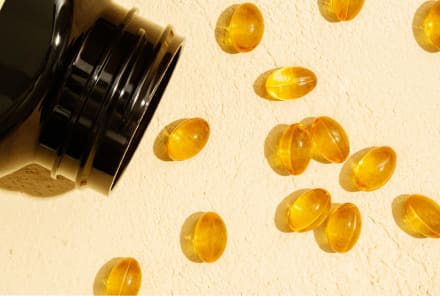Advertisement
What I Wish Everyone Knew About Anemia And Nutrition


Ashley Jordan Ferira, Ph.D., RDN is Vice President of Scientific Affairs at mindbodygreen. She received her bachelor's degree in Biological Basis of Behavior from the University of Pennsylvania and Ph.D. in Foods and Nutrition from the University of Georgia.
As a nutritionist, I frequently have clients come into my practice and tell me that they’ve been suffering from long-term anemia, most commonly from a deficiency in iron. Many of these people have been prescribed or told to take an iron supplement to replete their iron stores. Some experience constipation, nausea, and other digestive issues1 and stop taking the iron (which leads to repeat bouts of anemia). Some clients will even tell me that they’ve been iron deficient for their whole life no matter what they have tried before.
Iron deficiency gets all of the spotlight, but other causes and types of anemia also exist and can affect the body in similar ways—causing fatigue, generalized weakness, shortness of breath, irregular heartbeat, pale skin, and neurological symptoms like headache, brain fog, depression, or dizziness.
When we’re anemic2, there are not enough healthy red blood cells. And as a result, there's a lack of oxygen getting circulated via those red blood cells around the vessels of the body (and therefore, tissues and organs), including the brain. In fact, long-term deprivation of oxygen to the brain can lead to neurodegeneration and increase your risk for cognitive decline3.
However, many people who are anemic don’t realize that their anemia is even linked to their symptoms. Others aren't properly tested to determine if they're truly anemic and what the root cause is. Let’s clear up some of the confusion and look at three major causes of anemia.
1. Iron deficiency anemia.
First—and most notoriously—is iron deficiency. Without this essential mineral, we can't produce enough hemoglobin, an iron-rich protein that enables red blood cells to carry oxygen throughout our body.
Not consuming adequate iron from one’s diet (more common in vegetarians and vegans4) is the most obvious culprit, but iron losses can also occur in women during years of menstruation or from another source of bleeding (like undiagnosed bleeding in the GI tract).
On average, five percent5 of the overall U.S. population has anemia, but pregnant women and women of reproductive age, elderly individuals, and Black and Hispanic individuals are at the highest risk and experience anemia more frequently.
In a study of pregnant women in Canada, over 90 percent of the women were iron deficient (based on ferritin levels from a blood test), demonstrating how overlooked this nutrient of concern is. During pregnancy, iron needs6 almost double to compensate for iron losses (to the fetus, placenta, and during delivery) and the significant increase in the mom’s red blood cell mass.
With iron deficiency anemia, it's important to request lab tests for serum iron and ferritin, which is the storage form of iron. These two labs are often screened alongside a complete blood count (CBC) panel.
Several specific tests examine the degree to which the red blood cells are affected. Here’s what labs look like with iron deficiency anemia:
- Low serum iron
- Low ferritin
- Low hemoglobin (Hg)
- Low hematocrit (Hct)
- Low iron saturation
- High transferrin or total iron-binding capacity (TIBC)
- Blood smear will show small red blood cells with an oval shape and pale centers (microcytic anemia)
Per the National Academy of Medicine, daily iron needs are 18 mg for women 19 to 50 years, 27 mg during pregnancy, and 9 mg during lactation. The daily need drops to 8 mg for women 51 years and older (or whenever menstruation blood losses end, i.e., post-menopausal). Men need at least 8 mg of iron during all years of adulthood.
Iron-rich sources are meats (I prefer organic/grass-fed meats), seafood, legumes, leafy vegetables, and fortified grains. Vitamin C helps aid in absorption of iron7, so toss some fruits or broccoli alongside your meal too. Since the health of one’s gut and iron balance8 are inextricably linked, the health of one’s GI tract often goes hand-in-hand with anemia.
2. Anemia from inadequate B vitamins.
Anemia due to one or more B vitamins is determined by a CBC panel conducted as part of a regular blood screening. Other important labs to test include serum B6, serum B12, serum folate (and sometimes red blood cell folate), methylmalonic acid (MMA), and homocysteine levels.
These labs can be confusing, so here’s a simple breakdown of typical trends to help:
- Vitamin B6 deficiency — Normal MMA; High homocysteine
- Vitamin B12 deficiency — High MMA; High homocysteine
- Folate (vitamin B9) deficiency — Normal MMA; High homocysteine
B12 and folate deficiency both cause megaloblastic anemia (also called macrocytic anemia), which not involves not enough and larger-than-normal red blood cells. It’s important to rule out vitamin B12 as the causative factor first, because supplementing with folate can fix the dysfunctional red blood cells, but mask the persistent B12 deficiency9, leading to problems, including serious neurological issues10 and deficits.
In contrast, vitamin B6 deficiency manifests as microcytic anemia (small, pale red blood cells), which is also what happens with iron deficiency. So, you can see how the healthcare practitioner needs to be an astute detective when it comes to the nutrition culprits of anemia.
Vitamin B12
Because vitamin B12 is found mostly in animal protein sources (meat, fish, eggs, dairy), a deficiency can occur in those eating a poorly balanced vegetarian or vegan diet. B12 deficiency can also occur in those with low stomach acid, inadequate intrinsic factor11, and those with other imbalances (celiac disease, Crohn’s, etc.) or surgeries within the digestive tract that may block or limit absorption of nutrients.
Daily vitamin B12 needs are 2.4 micrograms (mcg) per day, although higher supplemental levels12 (e.g., 100 mcg and up) are safe and recommended for at-risk groups like older adults, vegans, and those with absorption issues.
Folate (vitamin B9)
When it comes to folate, leafy greens, legumes, broccoli, asparagus, citrus fruits, whole grains, and fortified cereals are good sources. Inadequate intake or malabsorption due to intestinal challenges or surgery are the more common causes of folate deficiency.
Adults need 400 mcg of folate each day, and requirements increase to 600 mcg during pregnancy (to prevent neural tube defects13) and 500 mcg for breastfeeding moms.
Vitamin B6
For vitamin B6, lack of protein intake and malabsorption issues are the most common causes of vitamin B6 deficiency. Fish, poultry, beef liver, starchy vegetables, non-citrus fruit, and fortified cereals are top food sources. Vitamin B6 daily intake recommendations are 1.3 to 2.0 mg during adulthood, depending on life stage, but 2.0 mg is a safe daily level14 for all adults to consume.
Whether through foods and/or a quality supplement (e.g., multivitamin or B complex), the importance of B vitamin sufficiency throughout life for anemia prevention is abundantly clear.
3. Anemia of chronic disease.
The least-commonly discussed type of anemia is what we call the anemia of inflammation or anemia of chronic disease 15(ACD). This type of anemia manifests similarly to an iron-deficiency anemia; however, serum iron levels can be normal. But you also want to measure ferritin levels, as they are typically high with chronic inflammation and indicate an imbalance in iron utilization. Other relevant labs to test include a CBC panel, transferrin, and reticulocyte count.
ACD is a unique anemia with many potential causes, but the similarity is the body is in an acute or chronic state of inflammation. This can be due to acute or chronic infections or inflammation, autoimmune disease (e.g., lupus, celiac disease, rheumatoid arthritis, etc.), kidney disease, cancer, and post-surgery.
Environmental pollutants16 or toxins can disrupt iron homeostasis and result in ACD. And more research is needed, but gut dysbiosis or microbial imbalances within the gastrointestinal tract17 may also play a role in ACD.
It is important to determine if ACD is the actual cause of the anemia because iron supplementation given during this state of inflammation can potentially cause more damage and oxidative stress (if iron deficiency is not the root cause). In fact, excess iron may have negative neurological consequences and serve as a risk factor for dementia18.
Don't despair: There's a lot you can do if you're anemic.
First of all, you want to have the proper testing done to identify the true cause of the anemia. If it is purely an mineral (iron) or vitamin (B6, B12, folate) deficiency, a high-dose supplement will be necessary to address that deficit.
For long-term maintenance, incorporating a variety of foods naturally rich in the nutrient(s) of interest is the best strategy, but a quality multivitamin can also provide additional assurance for filling potential gaps.
The moral of the story is that you want to understand WHY the anemia is happening. Working with a functional medicine doctor or nutritionist can help you to resolve the root cause to eliminate your symptoms for good.
Iron deficiency could be what's making you tired all the time.
18 Sources
- https://journals.plos.org/plosone/article?id=10.1371/journal.pone.0117383
- https://www.ncbi.nlm.nih.gov/books/NBK499994/#!po=3.12500
- https://www.ncbi.nlm.nih.gov/pmc/articles/PMC3775683/
- https://www.ncbi.nlm.nih.gov/pmc/articles/PMC6367879/
- https://journals.plos.org/plosone/article?id=10.1371/journal.pone.0166635
- https://www.ncbi.nlm.nih.gov/pmc/articles/PMC5701706/
- https://www.ncbi.nlm.nih.gov/pmc/articles/PMC3999603/
- https://www.ncbi.nlm.nih.gov/pmc/articles/PMC6315993/
- https://pubmed.ncbi.nlm.nih.gov/17972439/
- https://www.ncbi.nlm.nih.gov/pmc/articles/PMC3875920/
- https://www.ncbi.nlm.nih.gov/books/NBK546655/
- https://lpi.oregonstate.edu/mic/vitamins/vitamin-B12
- https://www.ncbi.nlm.nih.gov/pmc/articles/PMC4933077/
- https://lpi.oregonstate.edu/mic/vitamins/vitamin-B6
- https://www.ncbi.nlm.nih.gov/pmc/articles/PMC6536698/
- https://www.ncbi.nlm.nih.gov/pmc/articles/PMC4782969/
- https://www.ncbi.nlm.nih.gov/pmc/articles/PMC4504946/
- https://www.ncbi.nlm.nih.gov/pmc/articles/pmid/28879084/
Watch Next
Enjoy some of our favorite clips from classes
Enjoy some of our favorite clips from classes
What Is Meditation?
Mindfulness/Spirituality | Light Watkins
Box Breathing
Mindfulness/Spirituality | Gwen Dittmar
What Breathwork Can Address
Mindfulness/Spirituality | Gwen Dittmar
The 8 Limbs of Yoga - What is Asana?
Yoga | Caley Alyssa
Two Standing Postures to Open Up Tight Hips
Yoga | Caley Alyssa
How Plants Can Optimize Athletic Performance
Nutrition | Rich Roll
What to Eat Before a Workout
Nutrition | Rich Roll
How Ayurveda Helps Us Navigate Modern Life
Nutrition | Sahara Rose
Messages About Love & Relationships
Love & Relationships | Esther Perel
Love Languages
Love & Relationships | Esther Perel

















